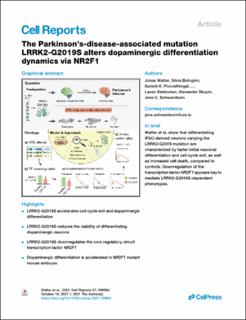The Parkinson's-disease-associated mutation LRRK2-G2019S alters dopaminergic differentiation dynamics via NR2F1
Walter, Jonas; Bolognin, Silvia; Poovathingal, Suresh K.; Magni, Stefano; Gérard, Deborah; Antony, Paul M. A.; Nickels, Sarah L.; Salamanca, Luis; Berger, Emanuel; Smits, Lisa M.; Grzyb, Kamil; Perfeito, Rita; Hoel, Fredrik; Qing, Xiaobing; Ohnmacht, Jochen; Bertacchi, Michele; Jarazo, Javier; Ignac, Tomasz; Monzel, Anna S.; Gonzalez-Cano, Laura; Krüger, Rejko; Sauter, Thomas; Studer, Michèle; Pereira de Almeida, Luis; Tronstad, Karl Johan; Sinkkonen, Lasse; Skupin, Alexander; Schwamborn, Jens C.
Journal article, Peer reviewed
Published version

Åpne
Permanent lenke
https://hdl.handle.net/11250/2837947Utgivelsesdato
2021Metadata
Vis full innførselSamlinger
- Department of Biomedicine [708]
- Registrations from Cristin [9489]
Sammendrag
Increasing evidence suggests that neurodevelopmental alterations might contribute to increase the susceptibility to develop neurodegenerative diseases. We investigate the occurrence of developmental abnormalities in dopaminergic neurons in a model of Parkinson’s disease (PD). We monitor the differentiation of human patient-specific neuroepithelial stem cells (NESCs) into dopaminergic neurons. Using high-throughput image analyses and single-cell RNA sequencing, we observe that the PD-associated LRRK2-G2019S mutation alters the initial phase of neuronal differentiation by accelerating cell-cycle exit with a concomitant increase in cell death. We identify the NESC-specific core regulatory circuit and a molecular mechanism underlying the observed phenotypes. The expression of NR2F1, a key transcription factor involved in neurogenesis, decreases in LRRK2-G2019S NESCs, neurons, and midbrain organoids compared to controls. We also observe accelerated dopaminergic differentiation in vivo in NR2F1-deficient mouse embryos. This suggests a pathogenic mechanism involving the LRRK2-G2019S mutation, where the dynamics of dopaminergic differentiation are modified via NR2F1.
